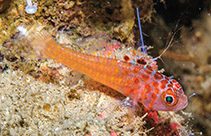| Family: |
Gobiidae (Gobies), subfamily: Gobiinae |
| Max. size: |
1.97 cm SL (female) |
| Environment: |
reef-associated; marine; depth range 50 - 65 m |
| Distribution: |
Western Pacific: Papua New Guinea. |
| Diagnosis: |
Dorsal spines (total): 7-7; Dorsal soft rays (total): 9-9; Anal spines: 1-1; Anal soft rays: 8-8. This species is distinguished by the following characters: predorsal midline with 8-9 scales; usually cycloid scales along the upper border of the opercle in up to 3 horizontal rows; without cheek scales; second dorsal spine very elongated, reaching posteriorly to the end of the second dorsal fin or beyond this (in specimens >18 mm SL); pectoral fin with branched middle rays; fifth pelvic fin ray branches once dichotomously and is 52-64% the length of the fourth ray; basal membrane connecting the inner margins of the fifth pelvic fins rays is less than 15% the length of the fifth ray (Ref. 95906). |
| Biology: |
Most Trimma species are found between 10-30 m, with relatively few occurring in depths shallower than this. In this case of Trimma irinae, this species occur at depths below about 50 m (Ref. 95906). |
| IUCN Red List Status: |
Data deficient (DD); Date assessed: 07 September 2021 Ref. (130435)
|
| Threat to humans: |
harmless |
| Country info: |
|
Source and more info: www.fishbase.org. For personal, classroom, and other internal use only. Not for publication.

